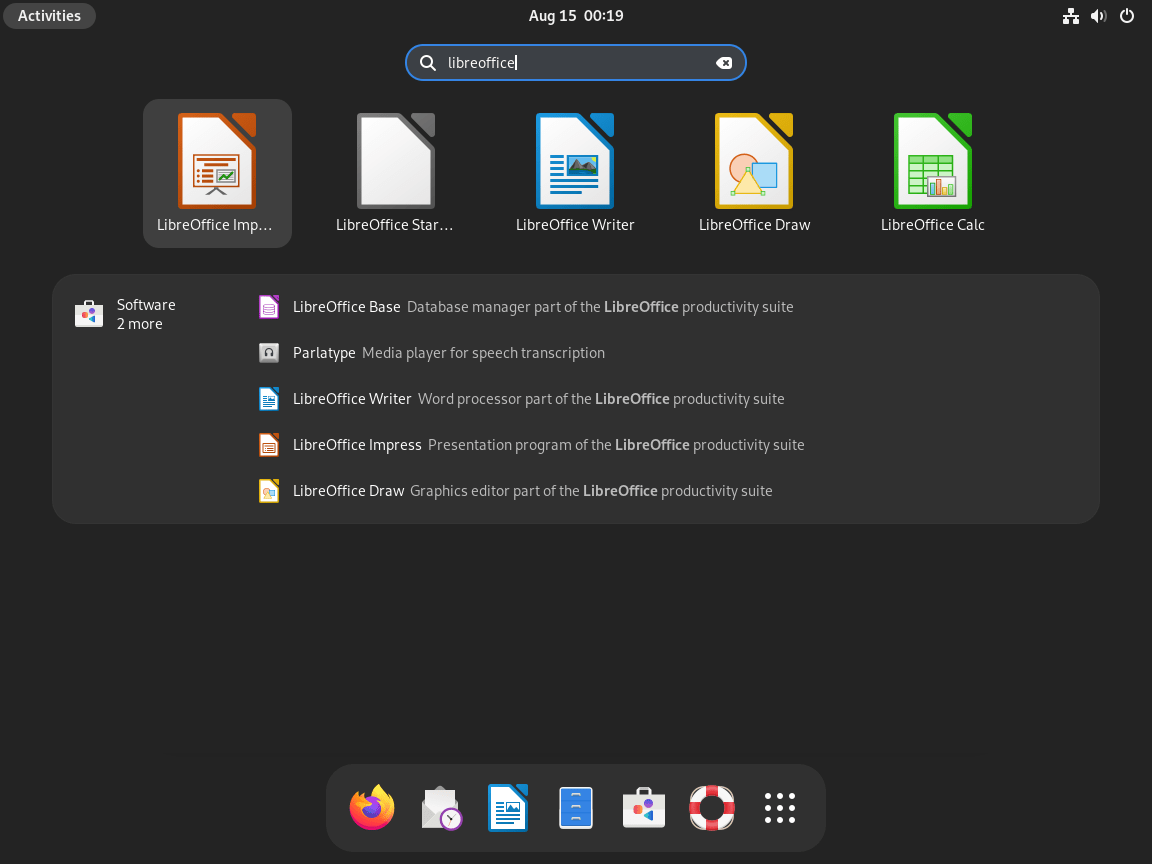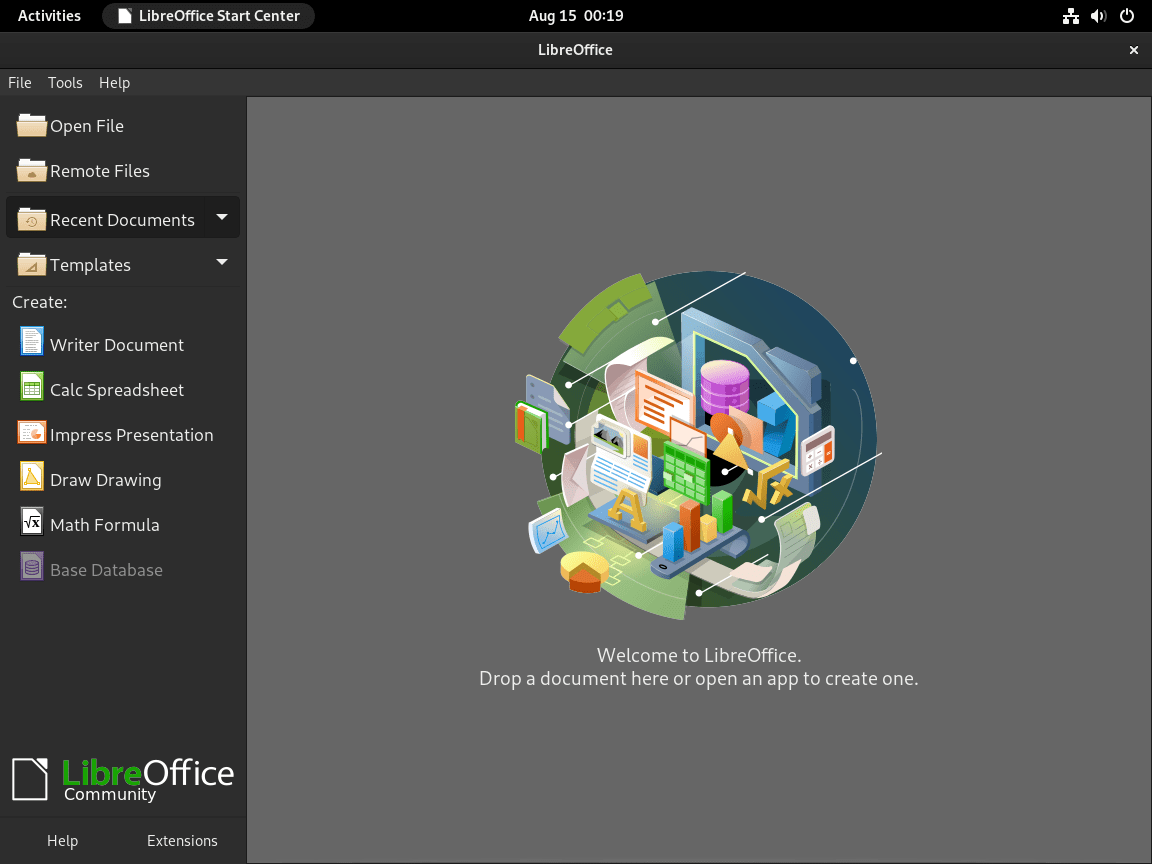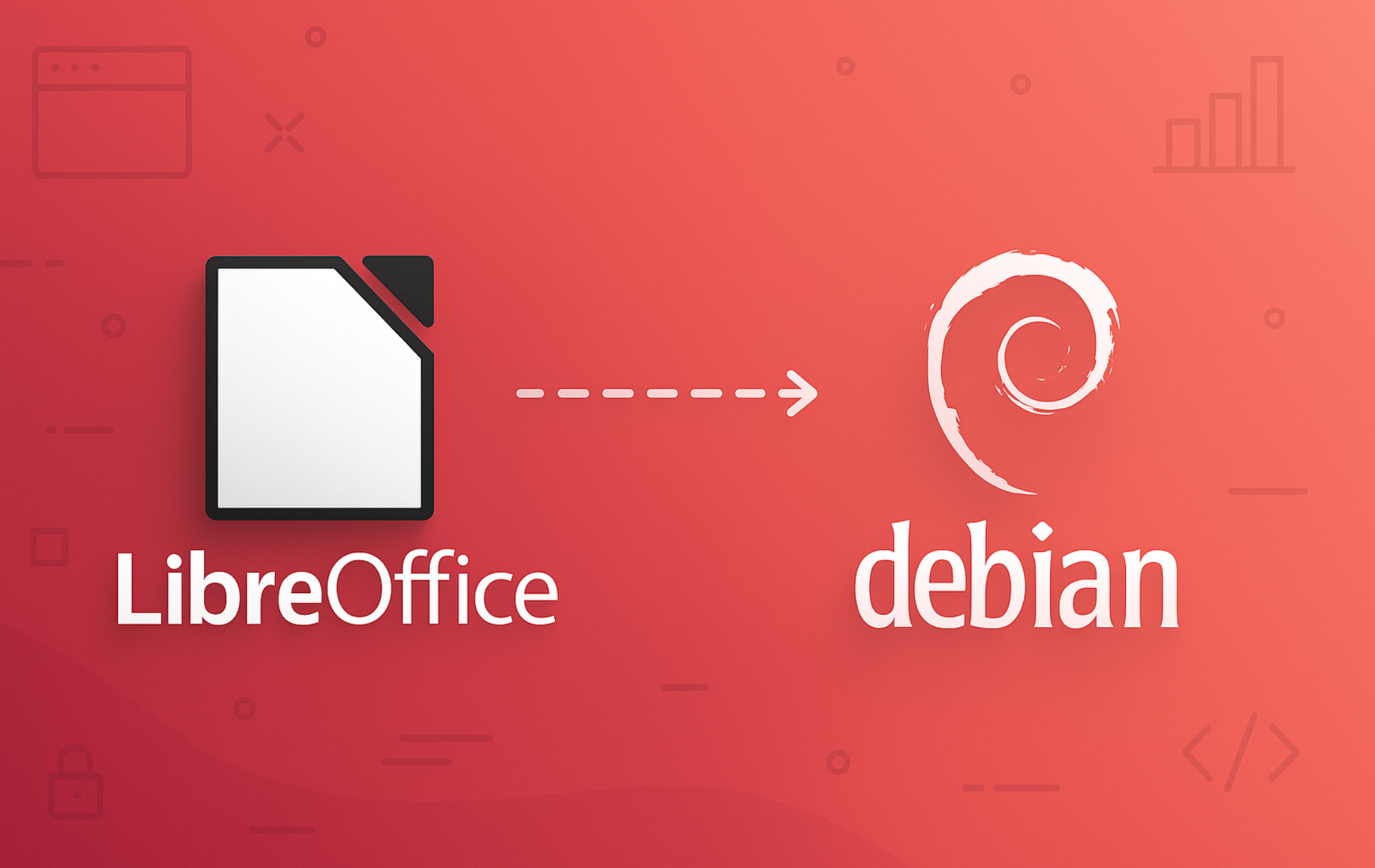Installing LibreOffice on Debian gives you a complete office suite for document creation and editing. Specifically, the suite includes Writer (word processor), Calc (spreadsheet), Impress (presentations), Draw (vector graphics), Base (database), and Math (formula editor). Furthermore, you can create, edit, and share documents in formats including DOCX, XLSX, PPTX, ODT, PDF, and more, which means it’s fully compatible with Microsoft Office and other office software.
LibreOffice can be installed on Debian using three primary methods: the system package manager (APT) for stable, integrated releases; Flatpak for the newest versions with sandboxing; or manual DEB packages for specific version control and offline installation. In practice, common use cases include writing documents with Microsoft Office compatibility, managing spreadsheets with pivot tables and charting, creating presentations with custom templates, and editing PDFs. Throughout this guide, you’ll learn to verify installed versions, manage updates, handle removal, and troubleshoot common issues like missing fonts or slow launch times.
Choose Your LibreOffice Installation Method
LibreOffice offers three installation paths on Debian, each with different version availability, update mechanisms, and integration levels. Therefore, you should choose the method that best matches your need for stability, newest features, or version control.
| Method | Channel | Version | Updates | Best For |
|---|---|---|---|---|
| APT Package Manager | Debian Repos | Stable (Debian-tested) | Automatic via apt upgrade | Most users who prefer system-integrated packages with distro-tested stability |
| Flatpak | Flathub | Latest stable | Automatic via flatpak update | Desktop users who want newest releases with sandboxing and frequent updates |
| Manual DEB Package | LibreOffice Downloads | User-selected | Manual redownload and reinstall | Users who need specific versions, offline installation, or version control |
For most users, the APT method is recommended because it provides automatic security updates and requires minimal maintenance. However, you should only use Flatpak if you specifically need the newest features, or alternatively, manual DEB packages if you require a specific version unavailable in repositories.
Method 1: Install LibreOffice via APT Default Repository
Update Debian Linux Before LibreOffice Installation
Before installing any new software, it’s a best practice to update the existing packages on your Debian system. In particular, this ensures compatibility and smooth operation.
sudo apt update
sudo apt upgradeInstall LibreOffice via APT
Once you’ve updated the system, you can then install the LibreOffice suite using the APT package manager.
sudo apt install libreofficeVerify LibreOffice Installation
After installation completes, you should verify LibreOffice is installed correctly by checking the version:
libreoffice --versionExpected output:
LibreOffice 7.0.4 (Debian 11), 7.4.7 (Debian 12), or 25.2.3 (Debian 13)
\nThe version shown depends on your Debian release. Debian 13 (Trixie) provides LibreOffice 25.x, Debian 12 (Bookworm) provides 7.4.x, and Debian 11 (Bullseye) provides 7.0.x.
Method 2: Install LibreOffice via Flatpak and Flathub
For users seeking the latest versions of LibreOffice, the default repositories might not suffice. While one could attempt APT pinning for unstable packages, this approach has risks. Consequently, given LibreOffice’s extensive package dependencies, using a third-party package manager like Flatpak becomes a more reliable choice. Additionally, Flatpak provides sandboxing that isolates LibreOffice from your system, which adds an extra layer of security.
Check Flatpak Installation
Before proceeding, first verify that Flatpak is installed on your system:
flatpak --versionExpected output:
Flatpak 1.x.x
If Flatpak is not installed, visit how to install Flatpak on Debian to install it first before continuing with the steps below.
Enable Flathub for LibreOffice
To access the vast collection of applications on Flathub, you first need to add the Flathub repository. This step is necessary because Flathub hosts thousands of applications, including the latest LibreOffice releases.
sudo flatpak remote-add --if-not-exists flathub https://flathub.org/repo/flathub.flatpakrepoInstall LibreOffice via Flatpak Command
With Flathub enabled, you can now install LibreOffice using Flatpak. Notably, this installation method will download the latest stable release directly from Flathub.
flatpak install flathub org.libreoffice.LibreOffice -yVerify Flatpak Installation
Confirm LibreOffice was installed successfully:
flatpak list | grep -i libreExpected output:
LibreOffice org.libreoffice.LibreOffice 25.x.x stable flathub system
Flathub updates frequently. The version shown will be the current stable release at the time of installation.
Method 3: Install LibreOffice via Manual DEB Package
The manual DEB package method gives you direct control over which LibreOffice version to install, making it ideal for users who need specific versions unavailable in repositories or require offline installation. Moreover, LibreOffice provides pre-built DEB packages in a tarball that contains all necessary components. This approach is particularly useful when you need to install LibreOffice on systems without internet access or when testing specific versions for compatibility.
Download LibreOffice DEB Package
Visit the LibreOffice download page, select “Linux x64 (deb)” as your operating system, and note the current version number. Then, download the tarball using wget:
cd /tmp
wget https://download.documentfoundation.org/libreoffice/stable/25.8.3/deb/x86_64/LibreOffice_25.8.3_Linux_x86-64_deb.tar.gzReplace
25.8.3with the current version from the download page. This version number appears in both the URL path (/stable/25.8.3/) and tarball name (LibreOffice_25.8.3_). Note that the extracted directory includes the full version with an additional digit (e.g.,25.8.3.2).
Extract and Install DEB Packages
Next, extract the tarball and navigate to the DEBS directory:
tar -xzf LibreOffice_25.8.3_Linux_x86-64_deb.tar.gz
cd LibreOffice_25.8.3.2_Linux_x86-64_deb/DEBSThe extracted directory name includes the full version (25.8.3.2) with an additional digit beyond the download version (25.8.3). This is expected behavior.
After navigating to the DEBS directory, install all DEB packages at once:
sudo apt install ./*.debThis installs LibreOffice to /opt/libreoffice25.8/ with all applications (Writer, Calc, Impress, Draw, Base, Math) and language support.
Install Desktop Integration Package
To add LibreOffice to your application menu and enable proper file associations, you should also install the desktop integration package:
cd /tmp/LibreOffice_25.8.3.2_Linux_x86-64_deb/DEBS/desktop-integration
sudo dpkg -i *.debVerify Manual Installation
Verify the installation by checking the version using the full path:
/opt/libreoffice25.8/program/soffice --versionExpected output:
LibreOffice 25.8.3.2 40(Build:2)
The version shown matches the DEB package you downloaded. The installation path uses the major.minor version only (e.g.,
/opt/libreoffice25.8/).
After installing the desktop integration package, LibreOffice appears in your application menu. You can also create a symbolic link to
/usr/local/bin/libreofficeif you prefer launching from the terminal using justlibreoffice.
Launching LibreOffice Suite
After successfully installing LibreOffice on your Debian system, you can open and use the suite in multiple ways. Specifically, you can choose to use the terminal or prefer a graphical approach.
Launch LibreOffice from the Terminal
Access your terminal application as you typically would on your Debian system, then open LibreOffice by inputting the following command:
libreofficeAlternatively, if you installed LibreOffice using Flatpak, the command differs slightly:
flatpak run org.libreoffice.LibreOfficeSimilarly, for manual DEB package installations, use the full path:
/opt/libreoffice25.8/program/sofficeLaunch LibreOffice from the Application Icon
Navigate to your application menu or dashboard and search “LibreOffice.” Once you locate the LibreOffice icon, click on it. Subsequently, this action will launch the LibreOffice suite, and from there, you can select the specific application (like Writer, Calc, or Impress) you wish to use.


Manage LibreOffice
Update LibreOffice
Update via APT
Updating LibreOffice if you’ve installed it using the APT package manager is straightforward. In fact, regularly updating ensures you have the latest features and security patches.
sudo apt update
sudo apt install --only-upgrade libreofficeVerify the update:
libreoffice --versionUpdate via Flatpak
On the other hand, the update process is slightly different but equally simple for those who’ve opted for the Flatpak installation.
flatpak update org.libreoffice.LibreOfficeVerify the update:
flatpak info org.libreoffice.LibreOffice | grep VersionUpdate Manual DEB Installation
Manual DEB installations require redownloading and reinstalling the tarball with the new version. First, you should check your current installed version:
/opt/libreoffice*/program/soffice --versionAfter checking your version, visit the LibreOffice download page, download the latest tarball, extract it, and then run:
cd /tmp/LibreOffice_[NEW-VERSION]_Linux_x86-64_deb/DEBS
sudo apt install ./*.debThe new version will overwrite the old installation in /opt/.
Remove LibreOffice
There might come a time when you need to uninstall LibreOffice, either to free up space or to resolve specific issues. Importantly, depending on your installation method, the removal process varies.
Remove APT Installation
If you’ve installed LibreOffice through the APT package manager on Debian, you can easily uninstall it using the following commands:
sudo apt remove libreoffice
sudo apt autoremoveAlternatively, to remove configuration files as well, use purge instead:
sudo apt purge libreoffice
sudo apt autoremoveVerify removal:
sudo apt update
apt-cache policy libreofficeExpected output:
libreoffice: Installed: (none) Candidate: 7.x.x or 25.x.x (depending on Debian version)
Finally, confirm the command is no longer available:
libreoffice --versionExpected output:
bash: libreoffice: command not found
Remove Flatpak Installation
Meanwhile, for users who’ve installed the Flatpak version of LibreOffice, the uninstallation command is:
flatpak uninstall org.libreoffice.LibreOffice -yVerify removal:
flatpak list | grep -i libreThis command should return no output.
Remove Manual DEB Installation
Manual DEB installations install to /opt/ and do not include an automated uninstaller. Therefore, you must remove the installation directory manually:
Warning: The following command permanently deletes the LibreOffice installation including any custom templates or extensions you may have added. If you have customized templates or extensions, back them up from
/opt/libreoffice25.8/before proceeding.
sudo rm -rf /opt/libreoffice25.8Next, remove the desktop integration package:
sudo apt remove libreoffice25.8-debian-menusAdditionally, clean up the downloaded tarball and extracted files:
rm -rf /tmp/LibreOffice_25.8.3_Linux_x86-64_deb.tar.gz /tmp/LibreOffice_25.8.3.2_Linux_x86-64_deb/Verify the installation directory is removed:
ls /opt/ | grep libreThis command should return no output, confirming complete removal.
Troubleshooting Common LibreOffice Issues
Manual DEB: Command Not Found Error
If you installed the manual DEB package and receive libreoffice: command not found, this is expected behavior. Specifically, the manual installation places LibreOffice in /opt/, which is not in your system PATH by default.
Error message:
bash: libreoffice: command not found
Diagnostic: Check if LibreOffice is installed in /opt/:
ls /opt/ | grep libreExpected output:
libreoffice25.8
Fix: Use the full path to launch LibreOffice, or create a symbolic link to /usr/local/bin:
sudo ln -s /opt/libreoffice25.8/program/soffice /usr/local/bin/libreofficeVerification:
libreoffice --versionFlatpak: Font Rendering Issues
Flatpak installations may not access system fonts properly, consequently causing missing or incorrect font rendering in documents.
Diagnostic: Check if fonts are missing by opening a document and looking for font substitution warnings or unexpected font rendering.
Fix: Grant LibreOffice Flatpak access to system fonts:
flatpak override --user org.libreoffice.LibreOffice --filesystem=/usr/share/fonts:roSimilarly, for locally installed fonts:
flatpak override --user org.libreoffice.LibreOffice --filesystem=~/.local/share/fonts:roVerification: Restart LibreOffice and check if the missing fonts now appear in the font selector.
Slow First Launch After Installation
LibreOffice may take 20-30 seconds to launch the first time after installation, regardless of installation method. This is completely normal behavior.
Diagnostic: This is expected behavior during the initial launch. Specifically, LibreOffice performs first-run tasks including:
- Creating user profile directories
- Indexing help documentation
- Initializing Java runtime (if Base is included)
- Building font cache
Fix: No action needed. Subsequent launches will be significantly faster (typically 2-3 seconds). However, if slow launches persist after the first run, check system resources:
free -h
df -hEnsure you have at least 1GB of free RAM and sufficient disk space for LibreOffice to operate smoothly.
LibreOffice Not Appearing in Application Menu
This issue typically occurs with manual DEB installations if the desktop integration package was not installed. Fortunately, the fix is straightforward.
Diagnostic: Check if the desktop integration package is installed:
dpkg -l | grep libreoffice | grep menuFix: Install the desktop integration package from the extracted tarball:
cd /tmp/LibreOffice_25.8.3.2_Linux_x86-64_deb/DEBS/desktop-integration
sudo dpkg -i *.debVerification: Log out and log back in, then check your application menu for LibreOffice entries. Alternatively, you can update the desktop database manually:
sudo update-desktop-databaseConclusion
You now have LibreOffice configured on Debian with Writer, Calc, Impress, and Draw ready for document work. As we covered, the APT method provides stable packages with automatic updates, Flatpak offers sandboxed newer releases, and manual DEB packages give precise version control. To extend functionality further, install Microsoft fonts on Debian for better compatibility, set up Timeshift backups to protect your work, or alternatively configure unattended upgrades to automate security updates.



Indeed, it is odd and counter-intuitive.
Gérard
Dear Sir,
At Step 3 of Method 1
I believe it is lsb_release (using an underscore character)
and not
lsb-release (using an hyphen character)
Either way, there must be an error at Step 3 of Method 1.
Joshua,
Oops!… I could be wrong here.. since the
lsb-release (with an hyphen) package exists!
https://packages.debian.org/bookworm/lsb-release
Gérard
Thanks for the follow-up and self-correction, Gérard. You caught exactly the confusion many people encounter. The command is
lsb_release(underscore), but the package name islsb-release(hyphen). Your instinct to double-check was spot on.The article has been completely rewritten since your May 2024 comment and no longer uses
lsb_releaseat all. The current version avoids that command because it is not available by default on minimal Debian installations, which causes confusion for readers working with server installs.Your attention to detail helped validate the need for clearer instructions. Thank you for taking the time to verify and report back.